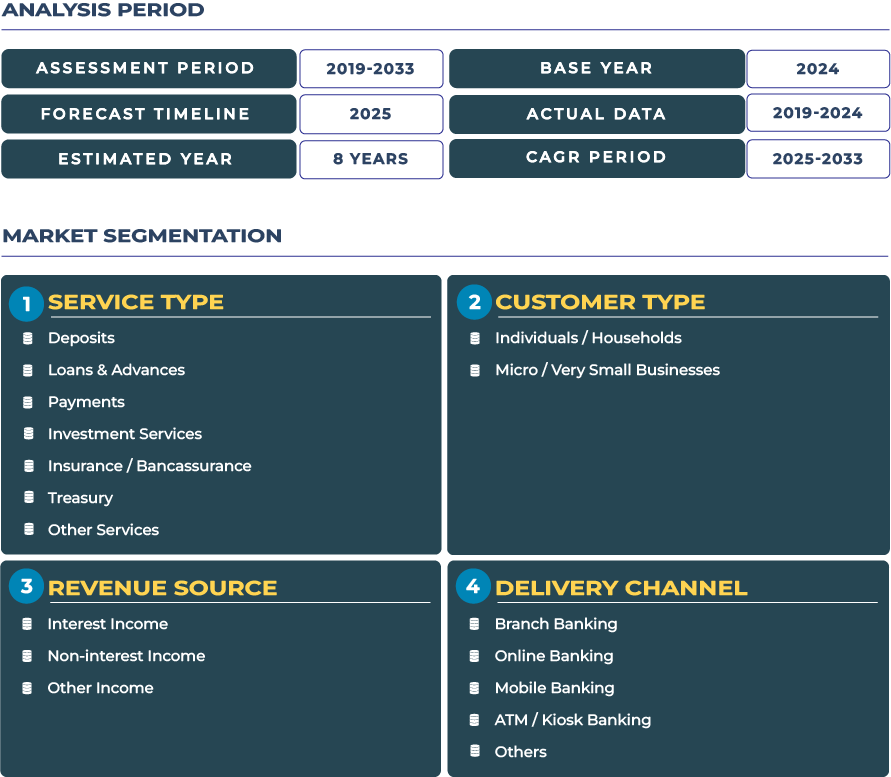Canada Retail Banking Market Outlook: AI-Infused Personalization Takes Center Stage
Canada is advancing its retail banking industry into a new era of intelligence and personalization. Fueled by fintech collaborations and adoption of AI advisory engines, Canadian institutions are reengineering customer engagement models to deliver real-time insights, predictive nudges, and hyper-tailored financial recommendations.
Note:* The market size refers to the total revenue generated by banks through interest income, non-interest income, and other ancillary sources.
In a landscape where digital maturity is rising, the retail banking market in Canada is expected to grow from USD 123.0 billion in 2025 to USD 161.5 billion in 2033, at a robust CAGR of 3.5%. This trajectory outpaces more mature markets and reflects headroom for digital penetration, product bundling, and cross-service integration. The foundational drivers will remain strong: consumer deposits, mortgage and consumer credit demand, and transaction volumes. But the additive engines will be value-added services-digital wealth management, embedded insurance, merchant finance, and modular lending initiatives targeted at underserved segments such as newcomers, Indigenous communities, and small businesses.
In macro terms, Canada benefits from stable political climate, durable regulatory institutions, and a banking sector characterized by resilience. However, global economic volatility, cross-border capital flows, and sensitivities to U.S. monetary policy could influence borrowing costs and credit demand. The ability of Canadian retail banks to invest in scalable technology, manage operational leverage, and convert digital adoption into monetizable services will determine who outpaces peers in the evolving retail banking landscape.
Drivers & Constraints: Long-Tail Forces Shaping the Canadian Retail Banking Arc
Driving Forces: Digital Inclusion, Government Support, and Mobile Penetration
One prominent growth lever is the government’s push toward financial inclusion and digital access. Canada already boasts account penetration among over 99% of adults. The federal and provincial authorities are actively supporting programs that reduce the digital divide in remote or Indigenous communities, expanding broadband and banking access. Concurrently, mobile wallet adoption and digital payments are accelerating; 77.6% of Canadians reported using online banking in 2022. These trends encourage banks to shift resource allocation toward digital channels and embed more intelligent advisory tools. Moreover, fintech firms and challenger banks are entering Canada, stimulating competition and spurring incumbents to invest in innovation and modernization. This confluence of inclusion, digital access, and competitive pressure provides fertile ground for growth of digital deposits, usage of digital advisory, and cross-sell of lending and insurance products.
Constraining Factors: High Fixed Costs, Legacy Branch Networks, and Rural Gaps
On the flip side, Canada retail banking market contends with structural constraints. Maintaining large branch networks and expensive physical infrastructure imposes high fixed costs, especially as usage shifts digital. Many rural or remote areas lag broadband connectivity, limiting digital uptake and reinforcing reliance on branch services. The pace of fintech adoption in those regions is slower, skewing growth toward populated corridors. Regulatory compliance-especially under OSFI guidelines such as B-15 on climate risk and E-21 on operational resilience-requires significant capital investment and governance infrastructure. Additionally, Canada banking sector is highly concentrated: the six largest banks command roughly 93% of total banking assets. This concentration presents competition challenges for smaller players and may slow radical innovation from incumbents wary of cannibalizing legacy revenue streams.
Trends & Opportunities: Signals Guiding Canada Retail Banking Future
Trend: Surge in Digital Payments, Mobile Banking, and Robo-Advisory Tools
A defining trend in Canada retail banking industry is the rise of digital payments and mobile wallets. Tokenization, real-time transfers, and integrated commerce solutions are becoming standard. Meanwhile, robo-advisory and algorithmic wealth tools are gaining traction, especially among younger and affluent segments seeking low-cost portfolio guidance within banking apps. Many banks are embedding savings nudges, personalized notifications, and investment prompts directly into mobile interfaces. As digital adoption deepens, more customers may shift toward “virtual-only” banking models. Research indicates that approximately 90% of Canadian banking customers use digital channels, and over 30% now bank exclusively via digital means.
Opportunity: AI-Based Advisory, SME Digital Lending, and Newcomer Banking Models
Among the most compelling opportunities is deploying AI-driven advisory platforms to deliver scalable, personalized financial planning, credit insights, and cross-product proposals. Retail banks can embed these features to convert passive depositors into proactive users of investments, insurance, or credit. Another growth vector lies in SME digital lending, leveraging alternative data and streamlined underwriting to serve small businesses overlooked by traditional credit scoring. Canada demographic shifts-with immigration and “newcomer” populations-offer additional opportunity. Many new Canadians initially prefer physical branches but gradually demand digital features; banks that hybridize onboarding and digital services can capture this segment.
Competitive Landscape: Strategic Plays Among Canada Banking Titans
Canadian banking is dominated by major players like Royal Bank of Canada, Toronto-Dominion Bank, Bank of Montreal, Scotiabank, CIBC, and National Bank. RBC continues to lead with scale and diversified operations. Royal Bank of Canada recently expanded its retail reach by acquiring HSBC’s Canadian operations, adding 780,000 clients and swelling its mortgage and consumer book. Among challengers, digital arms like Simplii Financial (CIBC’s digital banking division) are carving niches by offering low-fee, streamlined offerings. The National Bank of Canada is poised to scale further: it has agreed to acquire Canadian Western Bank in a C$5 billion deal, which will broaden its footprint and credit capacity.
Strategically, Canadian retail banks are investing in AI advisory platforms, migrating core systems to modular architectures, and deepening partnerships with fintechs for payments, credit underwriting, and data analytics. Some are also consolidating branch networks, redirecting capital toward digital transformation. The resultant dynamics are that scale remains critical, but banks that embed intelligent, data-driven services and secure infrastructure will outpace peers.







